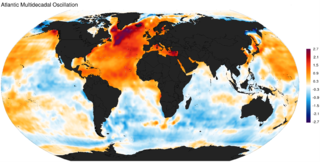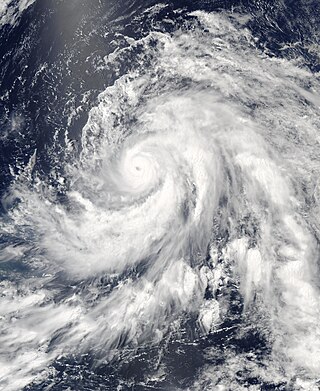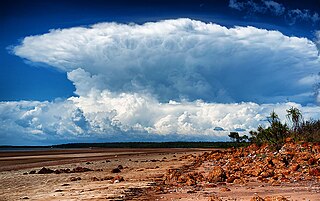Related Research Articles

Climate variability includes all the variations in the climate that last longer than individual weather events, whereas the term climate change only refers to those variations that persist for a longer period of time, typically decades or more. Climate change may refer to any time in Earth's history, but the term is now commonly used to describe contemporary climate change, often popularly referred to as global warming. Since the Industrial Revolution, the climate has increasingly been affected by human activities.

El Niño–Southern Oscillation (ENSO) is a global climate phenomenon that emerges from variations in winds and sea surface temperatures over the tropical Pacific Ocean. Those variations have an irregular pattern but do have some semblance of cycles. The occurrence of ENSO is not predictable. It affects the climate of much of the tropics and subtropics, and has links (teleconnections) to higher-latitude regions of the world. The warming phase of the sea surface temperature is known as El Niño and the cooling phase as La Niña. The Southern Oscillation is the accompanying atmospheric component, which is coupled with the sea temperature change. El Niño is associated with higher than normal air sea level pressure over Indonesia, Australia and across the Indian Ocean to the Atlantic. La Niña has roughly the reverse pattern: high pressure over the central and eastern Pacific and lower pressure through much of the rest of the tropics and subtropics. The two phenomena last a year or so each and typically occur every two to seven years with varying intensity, with neutral periods of lower intensity interspersed. El Niño events can be more intense but La Niña events may repeat and last longer.

The Intertropical Convergence Zone, known by sailors as the doldrums or the calms because of its monotonous windless weather, is the area where the northeast and the southeast trade winds converge. It encircles Earth near the thermal equator though its specific position varies seasonally. When it lies near the geographic Equator, it is called the near-equatorial trough. Where the ITCZ is drawn into and merges with a monsoonal circulation, it is sometimes referred to as a monsoon trough.

The Pacific decadal oscillation (PDO) is a robust, recurring pattern of ocean-atmosphere climate variability centered over the mid-latitude Pacific basin. The PDO is detected as warm or cool surface waters in the Pacific Ocean, north of 20°N. Over the past century, the amplitude of this climate pattern has varied irregularly at interannual-to-interdecadal time scales. There is evidence of reversals in the prevailing polarity of the oscillation occurring around 1925, 1947, and 1977; the last two reversals corresponded with dramatic shifts in salmon production regimes in the North Pacific Ocean. This climate pattern also affects coastal sea and continental surface air temperatures from Alaska to California.

The Atlantic Multidecadal Oscillation (AMO), also known as Atlantic Multidecadal Variability (AMV), is the theorized variability of the sea surface temperature (SST) of the North Atlantic Ocean on the timescale of several decades.

The Indian Ocean Dipole (IOD), also known as the Indian Niño, is an irregular oscillation of sea surface temperatures in which the western Indian Ocean becomes alternately warmer and then colder than the eastern part of the ocean.

Polar amplification is the phenomenon that any change in the net radiation balance tends to produce a larger change in temperature near the poles than in the planetary average. This is commonly referred to as the ratio of polar warming to tropical warming. On a planet with an atmosphere that can restrict emission of longwave radiation to space, surface temperatures will be warmer than a simple planetary equilibrium temperature calculation would predict. Where the atmosphere or an extensive ocean is able to transport heat polewards, the poles will be warmer and equatorial regions cooler than their local net radiation balances would predict. The poles will experience the most cooling when the global-mean temperature is lower relative to a reference climate; alternatively, the poles will experience the greatest warming when the global-mean temperature is higher.
Teleconnection in atmospheric science refers to climate anomalies being related to each other at large distances. The most emblematic teleconnection is that linking sea-level pressure at Tahiti and Darwin, Australia, which defines the Southern Oscillation. Another well-known teleconnection links the sea-level pressure over Iceland with the one over the Azores, traditionally defining the North Atlantic Oscillation (NAO).

A megadrought is an exceptionally severe drought, lasting for many years and covering a wide area.

Cyclonic Niño is a climatological phenomenon that has been observed in climate models where tropical cyclone activity is increased. Increased tropical cyclone activity mixes ocean waters, introducing cooling in the upper layer of the ocean that quickly dissipates and warming in deeper layers that lasts considerably more, resulting in a net warming of the ocean.
Caroline C. Ummenhofer is a physical oceanographer at the Woods Hole Oceanographic Institution where she studies extreme weather events with a particular focus on the Indian Ocean. Ummenhofer makes an effort to connect her discoveries about predicting extreme weather events and precipitation to helping the nations affected.

Pacific Meridional Mode (PMM) is a climate mode in the North Pacific. In its positive state, it is characterized by the coupling of weaker trade winds in the northeast Pacific Ocean between Hawaii and Baja California with decreased evaporation over the ocean, thus increasing sea surface temperatures (SST); and the reverse during its negative state. This coupling develops during the winter months and spreads southwestward towards the equator and the central and western Pacific during spring, until it reaches the Intertropical Convergence Zone (ITCZ), which tends to shift north in response to a positive PMM.
Ocean dynamical thermostat is a physical mechanism through which changes in the mean radiative forcing influence the gradients of sea surface temperatures in the Pacific Ocean and the strength of the Walker circulation. Increased radiative forcing (warming) is more effective in the western Pacific than in the eastern where the upwelling of cold water masses damps the temperature change. This increases the east-west temperature gradient and strengthens the Walker circulation. Decreased radiative forcing (cooling) has the opposite effect.

Fixed anvil temperature hypothesis is a physical hypothesis that describes the response of cloud radiative properties to rising surface temperatures. It presumes that the temperature at which radiation is emitted by anvil clouds is constrained by radiative processes and thus does not change in response to surface warming. Since the amount of radiation emitted by clouds is a function of their temperature, it implies that it does not increase with surface warming and thus a warmer surface does not increase radiation emissions by cloud tops. The mechanism has been identified both in climate models and observations of cloud behaviour, it affects how much the world heats up for each extra tonne of greenhouse gas in the atmosphere. However, some evidence suggests that it may be more correctly formulated as decreased anvil warming rather than no anvil warming.
The Rodwell–Hoskins mechanism is a hypothesis describing a climatic teleconnection between the Indian/Asian summer monsoon and the climate of the Mediterranean. It was formulated in 1996 by Brian Hoskins and Mark J. Rodwell [d]. The hypothesis stipulates that ascending air in the monsoon region induces atmospheric circulation features named Rossby waves that expand westward and interact with the mean westerly winds of the midlatitudes, eventually inducing descent of the air. Descending air warms and its humidity decreases, thus resulting in a drier climate during the summer months. The interaction of this atmospheric flow with topography further modifies the effect.
Sukyoung Lee is a professor at Pennsylvania State University known for her research on circulation in Earth's atmosphere and the Southern Ocean. In 2021 Lee was elected a fellow of the American Geophysical Union.
Rong Zhang is a Chinese-American physicist and climate scientist at the National Oceanic and Atmospheric Administration. Her research considers the impact of Atlantic meridional overturning circulation on climate phenomena. She was elected Fellow of the American Meteorological Society in 2018 and appointed their Bernhard Haurwitz Memorial Lecturer in 2020.

The southwestern North American megadrought is an ongoing megadrought in the southwestern region of North America that began in 2000. At least 24 years in length, the drought is the driest multi-decade period the region has seen since at least 800 CE. The megadrought has prompted the declaration of a water shortage at Lake Mead, the largest reservoir in the United States. Climate change models project drier conditions in the region through the end of the 21st century, though climate change mitigation may avoid the most extreme impacts.

Thomas L. Delworth is an atmospheric and oceanic climate scientist and Senior Scientist at the Geophysical Fluid Dynamics Laboratory (GFDL), part of NOAA. He also serves on the faculty of Oceanic Science at Princeton University.
Connie A. Woodhouse is a regents professor at the University of Arizona who is known for her use of tree rings to reconstruct the hydroclimate of the past, especially in western North America. In 2022 she was elected a fellow of the American Geophysical Union
References
- 1 2 Karnauskas et al. 2012, p. 5943.
- ↑ Karnauskas et al. 2012, p. 5944.
- ↑ Karnauskas et al. 2012, p. 5958.
- ↑ Coats et al. 2015, p. 125.
- ↑ Samanta et al. 2018, pp. 10609–10610.
- ↑ Coats et al. 2015, p. 136.
- ↑ Seager, Richard; Hoerling, Martin; Schubert, Siegfried; Wang, Hailan; Lyon, Bradfield; Kumar, Arun; Nakamura, Jennifer; Henderson, Naomi (September 2015). "Causes of the 2011–14 California Drought". Journal of Climate. 28 (18): 7021. Bibcode:2015JCli...28.6997S. doi:10.1175/jcli-d-14-00860.1. ISSN 0894-8755. S2CID 37382483.
- ↑ Karnauskas et al. 2012, p. 5959.
- ↑ Samanta et al. 2018, p. 10610.
- ↑ Samanta et al. 2018, p. 10616.
- ↑ O'Mara, Nicholas A.; Cheung, Anson H.; Kelly, Christopher S.; Sandwick, Samantha; Herbert, Timothy D.; Russell, James M.; Abella-Gutiérrez, Jose; Dee, Sylvia G.; Swarzenski, Peter W.; Herguera, Juan Carlos (2019). "Subtropical Pacific Ocean Temperature Fluctuations in the Common Era: Multidecadal Variability and Its Relationship With Southwestern North American Megadroughts". Geophysical Research Letters. 46 (24): 14669. Bibcode:2019GeoRL..4614662O. doi:10.1029/2019GL084828. ISSN 1944-8007. S2CID 214196860.
- ↑ Zhang et al. 2022, p. 569.
- ↑ Zhang et al. 2022, p. 562.
Sources
- Coats, Sloan; Smerdon, Jason E.; Cook, Benjamin I.; Seager, Richard (January 2015). "Are Simulated Megadroughts in the North American Southwest Forced?". Journal of Climate. 28 (1): 124–142. Bibcode:2015JCli...28..124C. doi: 10.1175/jcli-d-14-00071.1 . ISSN 0894-8755.
- Karnauskas, Kristopher B.; Smerdon, Jason E.; Seager, Richard; González-Rouco, Jesús Fidel (September 2012). "A Pacific Centennial Oscillation Predicted by Coupled GCMs" (PDF). Journal of Climate. 25 (17): 5943–5961. Bibcode:2012JCli...25.5943K. doi:10.1175/jcli-d-11-00421.1. hdl: 10261/75952 . ISSN 0894-8755.
- Samanta, Dhrubajyoti; Karnauskas, Kristopher B.; Goodkin, Nathalie F.; Coats, Sloan; Smerdon, Jason E.; Zhang, Lei (7 October 2018). "Coupled Model Biases Breed Spurious Low-Frequency Variability in the Tropical Pacific Ocean". Geophysical Research Letters. 45 (19): 10, 609–10, 618. Bibcode:2018GeoRL..4510609S. doi: 10.1029/2018gl079455 . hdl: 1912/10734 . ISSN 0094-8276.
- Zhang, Lei; Han, Weiqing; Karnauskas, Kristopher B.; Li, Yuanlong; Tozuka, Tomoki (15 January 2022). "Eastward Shift of Interannual Climate Variability in the South Indian Ocean since 1950". Journal of Climate. 35 (2): 561–575. Bibcode:2022JCli...35..561Z. doi:10.1175/JCLI-D-21-0356.1. ISSN 0894-8755. S2CID 240130097.